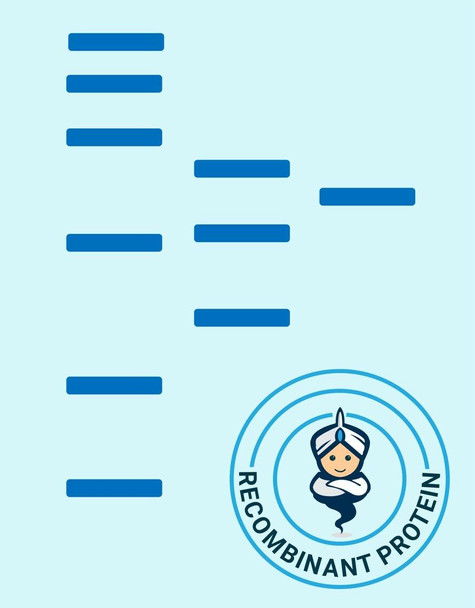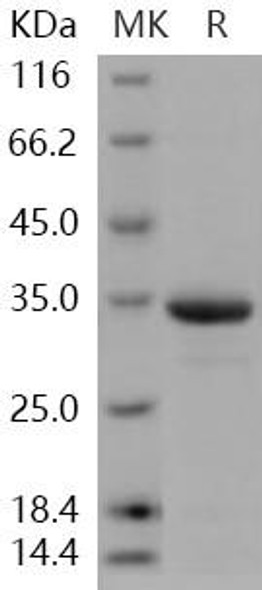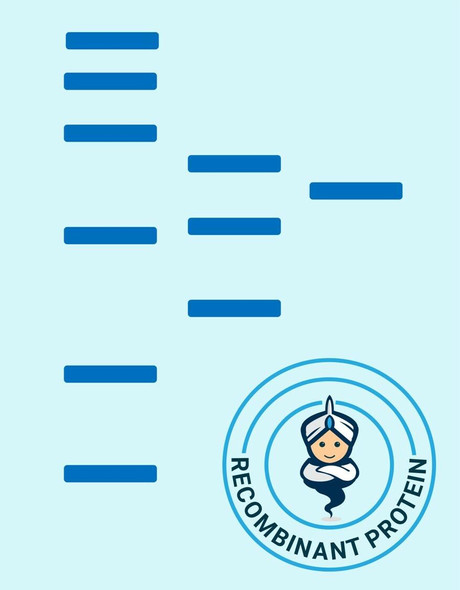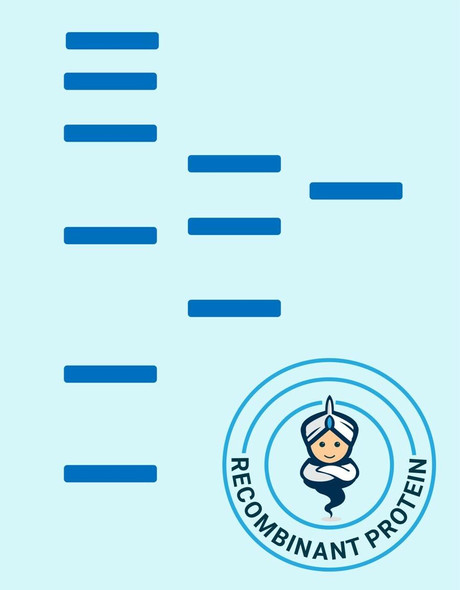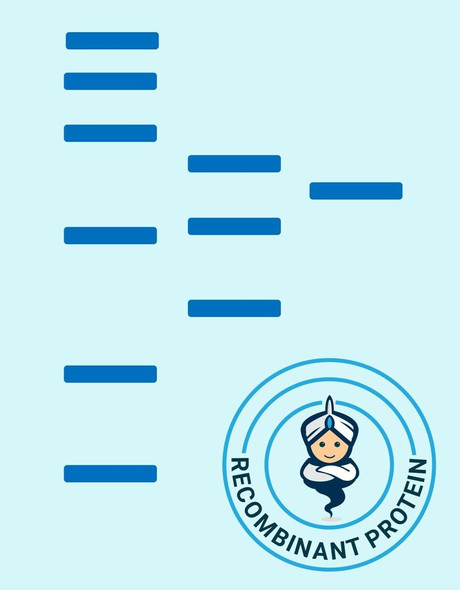Description
| Product Name: | Human HIF1A (85 a.a.) Recombinant Protein |
| Product Code: | RPPB3680 |
| Size: | 5µg |
| Species: | Human |
| Target: | HIF1A (85 a.a.) |
| Synonyms: | Hypoxia-inducible factor 1 alpha, HIF-1 alpha, HIF1 alpha, ARNT-interacting protein, Member of PAS protein 1, Basic-helix-loop-helix-PAS protein MOP1, HIF1A, MOP1, HIF1, PASD8, HIF-1A. |
| Source: | Escherichia Coli |
| Physical Appearance: | Sterile filtered colorless solution. |
| Formulation: | HIF1A Human (0.25mg/ml) solution containing 20mM Tris buffer(pH 8.0), 20% glycerol, 1mM DTT, 0.2M NaCl and 1mM EDTA. |
| Stability: | Store at 4°C if entire vial will be used within 2-4 weeks. Store, frozen at -20°C for longer periods of time.�For long term storage it is recommended to add a carrier protein (0.1% HSA or BSA).Avoid multiple freeze-thaw cycles. |
| Purity: | Greater than 80.0% as determined by SDS-PAGE. |
| Amino Acid Sequence: | MGSSHHHHHH SSGLVPRGSH MEGAGGANDK KKISSERRKE KSRDAARSRR SKESEVFYEL AHQLPLPHNV SSHLDKASVM RLTISYLRVR KLLDAGDLDI EDDMK |
HIF1A has a role as a master transcriptional monitor of the adaptive response to hypoxia. Under hypoxic conditions HIF1A activates the transcription of over 40 genes, including, erythropoietin, glucose transporters, glycolytic enzymes, vascular endothelial growth factor, and genes whose protein products increase oxygen release or facilitate metabolic adaptation to hypoxia. HIF1A functions as an essential role in embryonic vascularization, tumor angiogenesis and pathophysiology of ischemic disease.
HIF1A Recombinant Human produced in E.Coli is a single, non-glycosylated polypeptide chain containing 105 amino acids (1-85 a.a.) and having a molecular mass of 11.8 kDa. The HIF1A is fused to 20 amino acid His-Tag at N-terminus and purified by proprietary chromatographic techniques.
| UniProt Protein Function: | HIF1A: a master transcriptional regulator of the adaptive response to hypoxia. Under hypoxic conditions, activates the transcription of over 40 genes, including erythropoietin, glucose transporters, glycolytic enzymes, vascular endothelial growth factor, HILPDA, and other genes whose protein products increase oxygen delivery or facilitate metabolic adaptation to hypoxia. Plays an essential role in embryonic vascularization, tumor angiogenesis and pathophysiology of ischemic disease. Binds to core DNA sequence 5'-[AG]CGTG-3' within the hypoxia response element (HRE) of target gene promoters. Activation requires recruitment of transcriptional coactivators such as CREBPB and EP300. Activity is enhanced by interaction with both, NCOA1 or NCOA2. Interaction with redox regulatory protein APEX seems to activate CTAD and potentiates activation by NCOA1 and CREBBP. Involved in the axonal distribution and transport of mitochondria in neurons during hypoxia. Interacts with the HIF1A beta/ARNT subunit; heterodimerization is required for DNA binding. Interacts with COPS5; the interaction increases the transcriptional activity of HIF1A through increased stability. Interacts with EP300 (via TAZ-type 1 domains); the interaction is stimulated in response to hypoxia and inhibited by CITED2. Interacts with CREBBP (via TAZ-type 1 domains). Interacts with NCOA1, NCOA2, APEX and HSP90. Interacts (hydroxylated within the ODD domain) with VHLL (via beta domain); the interaction, leads to polyubiquitination and subsequent HIF1A proteasomal degradation. During hypoxia, sumoylated HIF1A also binds VHL; the interaction promotes the ubiquitination of HIF1A. Interacts with SENP1; the interaction desumoylates HIF1A resulting in stabilization and activation of transcription. Interacts (Via the ODD domain) with ARD1A; the interaction appears not to acetylate HIF1A nor have any affect on protein stability, during hypoxia. Interacts with RWDD3; the interaction enhances HIF1A sumoylation. Interacts with TSGA10. Interacts with RORA (via the DNA binding domain); the interaction enhances HIF1A transcription under hypoxia through increasing protein stability. Interaction with PSMA7 inhibits the transactivation activity of HIF1A under both normoxic and hypoxia- mimicking conditions. Interacts with USP20. Interacts with RACK1; promotes HIF1A ubiquitination and proteasome- mediated degradation. Interacts (via N-terminus) with USP19. Under reduced oxygen tension. Induced also by various receptor-mediated factors such as growth factors, cytokines, and circulatory factors such as PDGF, EGF, FGF2, IGF2, TGFB1, HGF, TNF, IL1B, angiotensin-2 and thrombin. However, this induction is less intense than that stimulated by hypoxia. Repressed by HIPK2 and LIMD1. Expressed in most tissues with highest levels in kidney and heart. Overexpressed in the majority of common human cancers and their metastases, due to the presence of intratumoral hypoxia and as a result of mutations in genes encoding oncoproteins and tumor suppressors. 2 isoforms of the human protein are produced by alternative splicing. |
| UniProt Protein Details: | Protein type:Autophagy; DNA-binding; Transcription factor Chromosomal Location of Human Ortholog: 14q23.2 Cellular Component: nucleoplasm; transcription factor complex; cytoplasm; nucleolus; nuclear speck; cytosol; nucleus Molecular Function:RNA polymerase II transcription factor activity, enhancer binding; histone deacetylase binding; Hsp90 protein binding; transcription factor binding; protein kinase binding; histone acetyltransferase binding; protein binding; signal transducer activity; enzyme binding; protein heterodimerization activity; sequence-specific DNA binding; ubiquitin protein ligase binding; transcription factor activity; nuclear hormone receptor binding Biological Process: lactation; oxygen homeostasis; embryonic placenta development; response to muscle activity; cellular iron ion homeostasis; positive regulation of transcription, DNA-dependent; glucose homeostasis; signal transduction; positive regulation of vascular endothelial growth factor receptor signaling pathway; muscle maintenance; negative regulation of bone mineralization; connective tissue replacement during inflammatory response; elastin metabolic process; axon transport of mitochondrion; regulation of transcription, DNA-dependent; visual learning; heart looping; angiogenesis; regulation of transcription from RNA polymerase II promoter in response to oxidative stress; neural crest cell migration; negative regulation of growth; hemoglobin biosynthetic process; positive regulation of neuroblast proliferation; negative regulation of TOR signaling pathway; regulation of transforming growth factor-beta2 production; Notch signaling pathway; collagen metabolic process; embryonic hemopoiesis; positive regulation of nitric-oxide synthase activity; positive regulation of erythrocyte differentiation; B-1 B cell homeostasis; digestive tract morphogenesis; mRNA transcription from RNA polymerase II promoter; positive regulation of chemokine production; positive regulation of angiogenesis; neural fold elevation formation; regulation of gene expression; positive regulation of hormone biosynthetic process; cartilage development; positive regulation of glycolysis; lactate metabolic process; response to hypoxia; epithelial to mesenchymal transition; positive regulation of transcription from RNA polymerase II promoter; positive regulation of endothelial cell proliferation; cerebral cortex development |
| NCBI Summary: | This gene encodes the alpha subunit of transcription factor hypoxia-inducible factor-1 (HIF-1), which is a heterodimer composed of an alpha and a beta subunit. HIF-1 functions as a master regulator of cellular and systemic homeostatic response to hypoxia by activating transcription of many genes, including those involved in energy metabolism, angiogenesis, apoptosis, and other genes whose protein products increase oxygen delivery or facilitate metabolic adaptation to hypoxia. HIF-1 thus plays an essential role in embryonic vascularization, tumor angiogenesis and pathophysiology of ischemic disease. Alternatively spliced transcript variants encoding different isoforms have been identified for this gene. [provided by RefSeq, Jul 2011] |
| UniProt Code: | Q16665 |
| NCBI GenInfo Identifier: | 2498017 |
| NCBI Gene ID: | 3091 |
| NCBI Accession: | Q16665.1 |
| UniProt Secondary Accession: | Q16665,Q53XP6, Q96PT9, Q9UPB1, C0LZJ3, |
| UniProt Related Accession: | Q16665 |
| Molecular Weight: | 95,634 Da |
| NCBI Full Name: | Hypoxia-inducible factor 1-alpha |
| NCBI Synonym Full Names: | hypoxia inducible factor 1, alpha subunit (basic helix-loop-helix transcription factor) |
| NCBI Official Symbol: | HIF1A�� |
| NCBI Official Synonym Symbols: | HIF1; MOP1; PASD8; HIF-1A; bHLHe78; HIF-1alpha; HIF1-ALPHA�� |
| NCBI Protein Information: | hypoxia-inducible factor 1-alpha; ARNT interacting protein; ARNT-interacting protein; HIF-1-alpha; PAS domain-containing protein 8; basic-helix-loop-helix-PAS protein MOP1; class E basic helix-loop-helix protein 78; hypoxia-inducible factor 1 alpha isoform I.3; hypoxia-inducible factor 1, alpha subunit (basic helix-loop-helix transcription factor); hypoxia-inducible factor1alpha; member of PAS protein 1; member of PAS superfamily 1 |
| UniProt Protein Name: | Hypoxia-inducible factor 1-alpha |
| UniProt Synonym Protein Names: | ARNT-interacting protein; Basic-helix-loop-helix-PAS protein MOP1; Class E basic helix-loop-helix protein 78; bHLHe78; Member of PAS protein 1; PAS domain-containing protein 8 |
| Protein Family: | Hypoxia-inducible factor |
| UniProt Gene Name: | HIF1A�� |
| UniProt Entry Name: | HIF1A_HUMAN |

